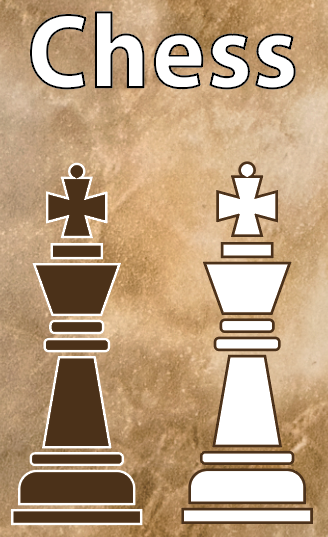
Chess
Chess is a popular two-player board game originating from northern India sometime in the 6th century AD. In late 15th century Europe the game evolved in its pieces and rules to form the basis the modern international chess game we know today.
The Equipment
One chess board - with a playing field consisting of 64 squares, which is sometimes annotated with letters and numbers along the sides. Two sets of 16 chess pieces (chessmen) - consisting of one king, one queen, two rooks, two bishops, two knights, and eight pawns. The darker color pieces and squares are referred to as black, and the lighter white.
Setup
The board is arranged into eight rows of squares and eight columns, with the lower left corner on both sides a black square. Set the pieces according to the illustration below.

Gameplay
Knowing how the pieces move is essential to playing the game. When your piece lands on the other player’s occupied square, their piece will be removed and considered captured. The movement path must be clear for a piece to move with exception of the Knight which can move over other pieces.
King - The king is the most important piece in the game and also the weakest. The king can move in any direction but only one space at a time. The game is lost if it is captured.

Queen – Queens are the most powerful pieces and can move in any direction any number of squares.

Rook – Rooks can move horizontally or vertically any number of squares.

Bishop – Bishops can move diagonally any number of squares.

Knight – Knights move in an “L” shape, either two squares horizontally and one square vertically, or two squares vertically and one square horizontally. Knights are the only pieces that can pass over other pieces that are in their movement path.

Pawn – Pawns can only move forward, unlike other pieces. Normally it moves only one square at a time except on its first move where it has the option to move up to two squares. Pawns cannot capture other pieces in front of them. However, if there is a piece one square diagonally forward of them, it can move in that direction to capture it. If a pawn manages to reach the other end of the board, it is promoted to a queen

Castling – This is a special move in chess that involves both a rook and the king. In this move, the king is moved two squares towards the rook, and the rook moves to the square through which the king passed. This occurs all within one turn.

Check - Check is a term in chess when a player's king is attacked and put in the position of being captured within one more move. A check cannot be ignored, and a player must stop the threat by doing one of the following:
- Capture the checking piece by using the king or any other piece that can capture the checking piece.
- Blocking the checking piece to protect the king.
- Move the king to a square which is not under threat.

Checkmate - also known as ‘Mate’ is when a player's king is checked and cannot get out of being captured. Giving checkmate to your opponent is the primary goal in chess: a player who receives the checkmate loses the game.

Basic Strategy
- Gain control of the center of the board, as this will allow your pieces to move more freely and deny the other player as much room to move.
- Create threats with your moves. If you are on offense, they need to think defense. - Try not to move the same piece twice in a row. This slows down your tempo and allows your opponent an opportunity to outpace you.
- Keep your king safe and unexposed to danger.
Now that you have learned the basics of Chess, you are ready to play!
“Every chess master was once a beginner.” – Irving Chernev
Shop for a Chess Set
© 2024 Yellow Mountain Imports, Inc.



